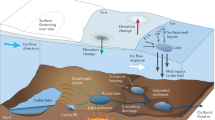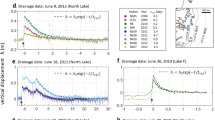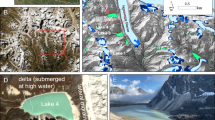Abstract
The existence of many subglacial lakes1 provides clear evidence for the widespread presence of water beneath the East Antarctic ice sheet, but the hydrology beneath this ice mass is poorly understood2. Such knowledge is critical to understanding ice flow, basal water transfer to the ice margin, glacial landform development and subglacial lake habitats. Here we present ice-sheet surface elevation changes in central East Antarctica that we interpret to represent rapid discharge from a subglacial lake. Our observations indicate that during a period of 16 months, 1.8 km3 of water was transferred over 290 km to at least two other subglacial lakes. While viscous deformation of the ice roof above may moderate discharge, the intrinsic instability of such a system3 suggests that discharge events are a common mode of basal drainage4. If large lakes, such as Lake Vostok or Lake Concordia1, are pressurizing, it is possible that substantial discharges could reach the coast5,6. Our observations conflict with expectations that subglacial lakes have long residence times and slow circulations2,7,8, and we suggest that entire subglacial drainage basins may be flushed periodically. The rapid transfer of water between lakes would result in large-scale solute and microbe relocation, and drainage system contamination from in situ exploration is, therefore, a distinct risk.
This is a preview of subscription content, access via your institution
Access options
Subscribe to this journal
Receive 51 print issues and online access
$199.00 per year
only $3.90 per issue
Buy this article
- Purchase on Springer Link
- Instant access to full article PDF
Prices may be subject to local taxes which are calculated during checkout


Similar content being viewed by others
References
Siegert, M. J., Carter, S., Tabacco, I., Popov, S. & Blankenship, D. A revised inventory of Antarctic subglacial lakes. Antarct. Sci. 17, 453–460 (2005)
Siegert, M. J. et al. Physical, chemical and biological processes in Lake Vostok and other Antarctic subglacial lakes. Nature 414, 603–609 (2001)
Nye, J. F. Water flow in glaciers, jökulhlaups, tunnels and veins. J. Glaciol. 17, 181–207 (1976)
Fowler, A. C. Breaking the seal at Grimsvotn, Iceland. J. Glaciol. 45, 506–516 (1999)
Denton, G. E. & Sugden, D. E. Meltwater features that suggest Miocene ice-sheet overriding of the Transantarctic Mountains in Victoria Land, Antarctica. Geograf. Ann. 87, 67–85 (2005)
Sawagaki, T. & Hirakawa, K. Erosion of bedrock by subglacial meltwater, Soya Coast, East Antarctica. Geograf. Ann. 79, 223–238 (1997)
Kapitsa, A., Ridley, J. K., Robin, G. de Q., Siegert, M. J. & Zotikov, I. Large deep freshwater lake beneath the ice of central East Antarctica. Nature 381, 684–686 (1996)
Bell, R. E. et al. Origin and fate of Lake Vostok water refrozen to the base of the East Antarctic ice sheet. Nature 416, 307–310 (2002)
Siegert, M. J., Taylor, J. & Payne, A. J. Spectral roughness of subglacial topography and implications for former ice-sheet dynamics in East Antarctica. Glob. Planet. Change 45, 249–263 (2005)
Shreve, R. L. Movement of water in glaciers. J. Glaciol. 11, 205–214 (1972)
Wingham, D. J., Ridout, A., Scharroo, R., Arthern, R. & Shum, C. K. Antarctic elevation change from 1992 to 1996. Science 282, 456–458 (1998)
Gray, L. et al. Evidence for subglacial water transport in the West Antarctic Ice Sheet through three-dimensional satellite radar interferometry. Geophys. Res. Lett. 32, L03501, doi:10.1029/2004GL021387 (2005)
Joughin, I., Kwok, R. & Fahnestock, M. Estimation of ice-sheet motion using satellite radar interferometry: Method and error analysis with application to Humboldt Glacier, Greenland. J. Glaciol. 42, 564–575 (1996)
Roberts, M. J. Jokulhlaups: a reassessment of floodwater flow through glaciers. Rev. Geophys. 43, doi:10.1029/2003RG000147 (2005)
van der Veen, C. J. Fundamentals of Glacier Dynamics 1–462 (Balkema, Rotterdam, 1999)
Björnsson, H. Hydrological characteristics of the drainage system beneath a surging glacier. Nature 395, 771–774 (1998)
Kamb, B. Glacier surge mechanism based on linked cavity configuration of the basal water conduit system. J. Geophys. Res. 92, 9083–9100 (1987)
Lythe, M. B., Vaughan, D. G. & the BEDMAP consortium. Bedmap–Bed Topography of the Antarctic. 1:10,000,000 map. Misc. 9 (British Antarctic Survey, Cambridge, 2000)
Huybrechts, P. The Antarctic ice sheet and environmental change: a three dimensional modelling study. Rep. Polar Res. 99, 1–241 (Alfred-Wegener-Institut für Polar und Meeresforschung, 1992)
Studinger, M., Bell, R. E. & Tikku, A. A. Estimating the depth and shape of subglacial Lake Vostok's water cavity from aerogravity data. Geophys. Res. Lett. 31, L12401, doi:10.1029/2004GL019801(2004)
McKay, C. P., Hand, K. P., Doran, P. T., Andersen, D. T. & Priscu, J. C. Clathrate formation and the fate of noble and biologically useful gases in Lake Vostok, Antarctica. Geophys. Res. Lett. 30, doi:10.1029/2003GL017490 (2003)
Royston-Bishop, G., Tranter, M., Siegert, M. J., Lee, V. & Bates, P. D. Is Vostok lake in steady state? Ann. Glaciol. 39, 490–494 (2004)
Acknowledgements
We thank A. Fowler and I. Joughin for their insights and A. Payne and A. Le Brocq for assistance with the calculation of water flow paths. Funding for this work was provided by the NERC Centre for Polar Observation and Modelling. Author Contributions D.J.W. identified altimetric changes across the study region and undertook the calculations of energy exchange and water flow. M.J.S. placed the altimetric changes in the context of subglacial topography and the locations of known subglacial lakes. A.P.S. processed interferometric synthetic aperture radar data in Fig. 1b. A.S.M. processed ERS-2 altimetric records. D.J.W. and M.J.S. wrote the paper. All authors discussed the results and commented on the manuscript.
Author information
Authors and Affiliations
Corresponding authors
Ethics declarations
Competing interests
Reprints and permissions information is available at npg.nature.com/reprintsandpermissions. The authors declare no competing financial interests.
Supplementary information
Supplementary Figure 1
Rapid drainage and hydraulic connection of Antarctic subglacial lakes, inferred from satellite altimetric measurements of the ice sheet surface over the Adventure Subglacial Trench, East Antarctica between 1996 and 2003. (DOC 177 kb)
Supplementary Figure 2
Antarctic subglacial water flowpaths. (DOC 232 kb)
Supplementary Figure 3
ERS-2 InSAR data and altimeter measurements (coloured circles) over Lake L. (DOC 899 kb)
Supplementary Figure 4
A simple model of the exchange between two lakes. (DOC 50 kb)
Supplementary Methods 1
The volume of exchange. (DOC 25 kb)
Supplementary Methods 2
Calculation of Basal Hydraulics. (DOC 165 kb)
Supplementary Methods 3
The periodicity of discharges and the fate of the lake water. (DOC 25 kb)
Rights and permissions
About this article
Cite this article
Wingham, D., Siegert, M., Shepherd, A. et al. Rapid discharge connects Antarctic subglacial lakes. Nature 440, 1033–1036 (2006). https://doi.org/10.1038/nature04660
Received:
Accepted:
Published:
Issue Date:
DOI: https://doi.org/10.1038/nature04660
This article is cited by
-
Outbursts from an ice-marginal lake in Antarctica in 1969–1971 and 2017, revealed by aerial photographs and satellite data
Scientific Reports (2023)
-
Enhanced subglacial discharge from Antarctica during meltwater pulse 1A
Nature Communications (2023)
-
Subglacial lakes and their changing role in a warming climate
Nature Reviews Earth & Environment (2022)
-
Greenland melt drives continuous export of methane from the ice-sheet bed
Nature (2019)
-
Spatio-temporal variability of processes across Antarctic ice-bed–ocean interfaces
Nature Communications (2018)
Comments
By submitting a comment you agree to abide by our Terms and Community Guidelines. If you find something abusive or that does not comply with our terms or guidelines please flag it as inappropriate.



